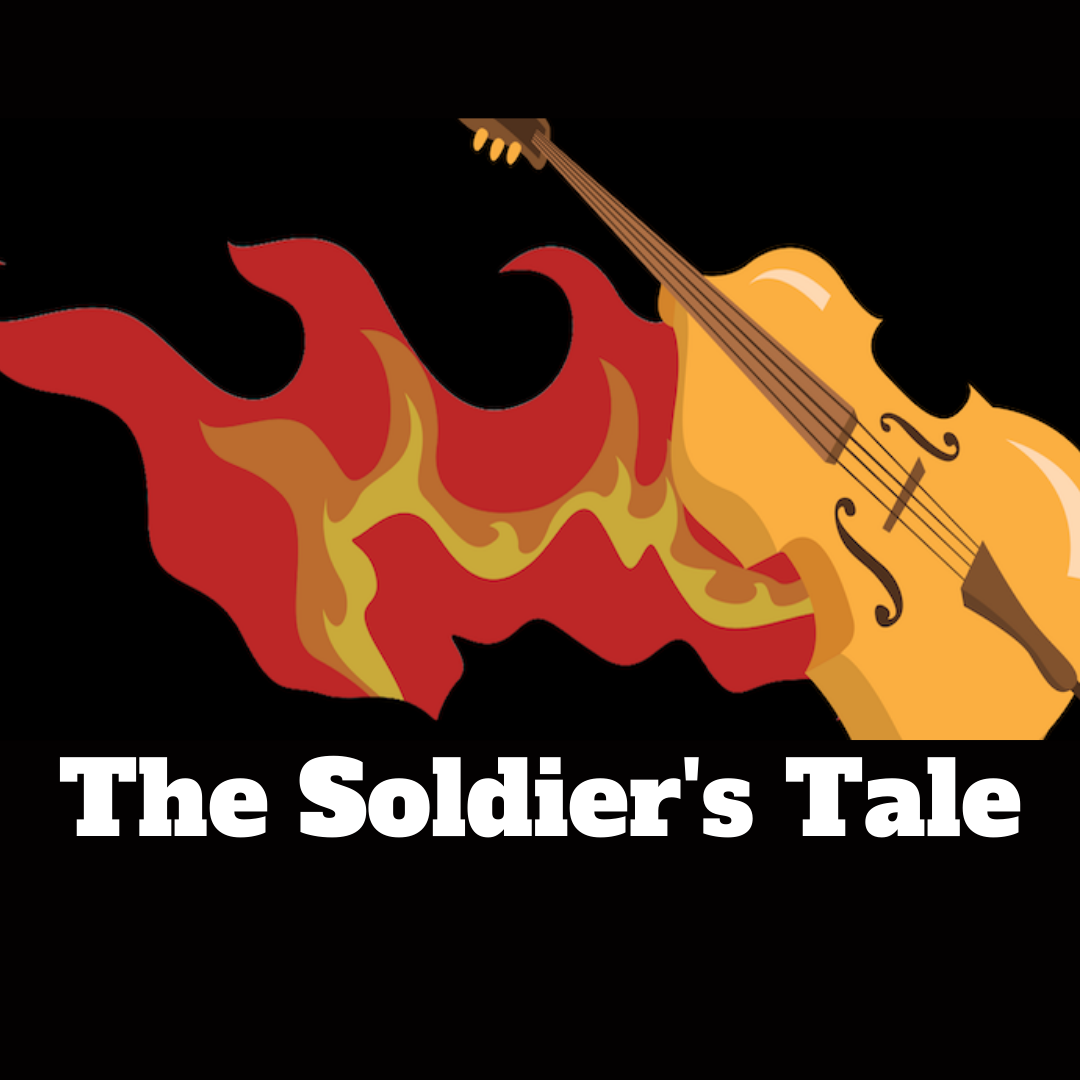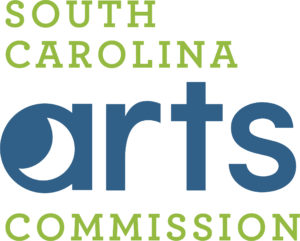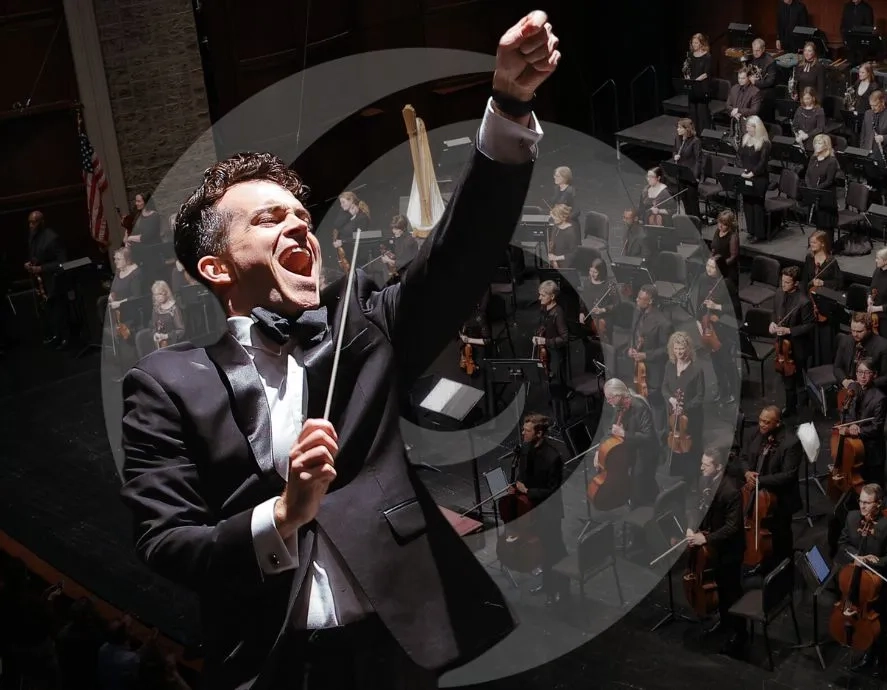
"The Soldier's Tale"
Friday, March 4, 2022, at 8:00 p.m.
Saturday, March 5, 2022, at 8:00 p.m.
Sunday, March 6, 2022, at 3:00 p.m.
Gunter Theater
Edvard Tchivzhel, Music Director & Conductor
David Bean, Narrator
Dancers from the International Ballet
Maggie Lewis (The Princess)
Denys Simon (The Solider)
Val Salnikov (The Devil)
*Dancers from the International Ballet sponsored by Greta and Graham Somerville
IGOR STRAVINSKY (1882-1971)
L'Histoire du soldat (The Soldier's Tale)
(Approximately 65 minutes)
Part One
1. The Solder's March
2. Airs by a Stream
3. Reprise: The Soldier's March
4. Pastorale
5. Reprise: Airs by the Stream
6. Reprise Two: Airs by the Stream
Part Two
7. The Soldier's March
8. The Royal March
9. The Little Concert
10. Three Dances: Tango, Waltz, Ragtime
11. The Devil's Dance
12. Little Chorale
13. The Devil's Song
14. Grand Chorale
15. Triumphal March of the Devil
![]()
Funded in part by a grant from the Metropolitan Arts Council, which receives funding from the City of Greenville, SEW Eurodrive, BMW Manufacturing Company, LLC, Michelin North America, Inc., and the South Carolina Arts Commission with support from the National Endowment for the Arts.
This organization is funded in part by the
South Carolina Arts Commission which receives support
from the National Endowment for the Arts.
The Soldier’s Tale
Program Notes by Paul Hyde
--------------------------------------------------------------------------
‘The Soldier’s Tale’
Igor Stravinsky (1882-1971)
“The Soldier’s Tale” (1918) is a theatrical work “to be read, played and danced,” as Stravinsky described it. It features a small chamber ensemble — with an unusual combination of instruments — and prominent roles for a narrator and three actors or dancers.
Stravinsky and the Swiss writer C.F. Ramuz based the work on a Russian folk tale with the colorful title of “The Runaway Soldier and the Devil.”
In many respects, the tale is a traditional story of pride leading to a fall. A soldier, Joseph, makes a Faustian bargain for immense wealth, and it brings him only disappointment.
Stravinsky’s choice of instruments was influenced by his discovery of American jazz. Indeed, the instrumental combo partially resembles an early jazz band. The work is written for a septet of violin, double bass, clarinet, bassoon, cornet (or trumpet), trombone, and percussion.
The choice of a small ensemble was due to practical considerations as well. In the closing months of World War I, Stravinsky and Ramuz had limited access to funding. They wanted to create a piece that could easily be taken on a tour of Switzerland, where both men were living at the time.
Stravinsky’s score includes haunting chorales and highly syncopated dances, the latter filled with the Russian composer’s characteristic sardonic wit.
Following is a synopsis of “The Soldier’s Tale”:
Act I
The tale begins with a solitary soldier, Joseph, wearily marching to his hometown and looking forward to several days of leave. The “Soldier’s March,” heard at the beginning, will return at various points in the story. It’s a whimsical piece, highly syncopated, suggesting the somewhat tired, irregular gait of the soldier.
Joseph sits down by a stream and begins to play an upbeat folk-sounding tune (“Airs by a Stream”) on his violin. The devil appears disguised as an old man carrying a butterfly net, but Joseph does not notice him at first. Soon, however, the devil sneaks up on Joseph, startling him.
The devil persuades Joseph to exchange his violin for a magic book that will bring him great wealth. The devil then convinces Joseph to spend three days with him so Joseph can understand the book. After three days, the devil takes Joseph home, and we hear a reprise of the “Soldier’s March.”
Back in his village, Joseph finds that his mother and friends are frightened to see him. He discovers also that his fiancée is married with two children. He realizes that three years, not three days, have passed, and the residents of the town think he’s a ghost. As Joseph contemplates his future, the ensemble plays a haunting “Pastorale.”
Joseph finds the devil and confronts him. The devil tries to calm Joseph by reminding him of the power of the book. But great wealth brings Joseph no pleasure. He merely wants the things he had before, the ordinary joys of life. (We hear a reprise of the jolly “Airs by a Stream.”) He realizes the poor have little material wealth, but they have happiness.
The devil arrives disguised as an old female peddler, who shows Joseph various items. When the devil offers a violin, Joseph takes it but can no longer play. (But we hear a reprise of the “Airs by a Stream.”) In anger, Joseph hurls the violin away and tears up the book.
Act II
Joseph leaves his home with nothing, marching past his hometown. We hear the “Soldier’s March” again.
He arrives at an inn where he hears the news that the king’s daughter is sick, and whoever can raise her from her bed will be given her hand in marriage. He makes his way to the Palace gates to a spirited tune, “The Royal March.”
At the palace, the devil is disguised as a virtuoso violinist. The narrator tells Joseph that the reason the devil controls him is because Joseph still has some of the devil’s money. If Joseph loses all of his money to the devil in a card game, he will finally be free.
The plan works: the devil falls, and Joseph is free. He takes the violin and plays a melody, “The Little Concert.” Joseph triumphantly marches into the princess’ chambers and starts to play another tune, “Three Dances,” consisting of a tango, a waltz, and a ragtime piece. The princess is miraculously revived by the music and begins to dance.
Joseph and the princess embrace. The devil arrives suddenly, but Joseph realizes he can defeat the devil by playing his violin. The ensemble plays the almost frenzied piece called “The Devil’s Dance.” The devil cannot resist the music. Eventually exhausted, he falls to the ground. The soldier takes the princess' hand, and together they drag the devil away, then fall into each other's arms. ("Little Chorale")
The devil pops his head in, however, and begins to torment the couple, warning them that Joseph may not leave the castle or the devil will regain control of him. (“The Devil’s Song”)
Over the “Grand Chorale,” the narrator delivers the moral of the story: a warning against wanting too much.
In the end, Joseph leaves the castle. The devil is waiting for Joseph. The devil beckons and Joseph follows. The last piece is “The Triumphal March of the Devil,” featuring violin and percussion entwined in a rhythmic duel, and the final measures are played solely by the percussionist.
Paul Hyde, a longtime Upstate journalist, teaches English at Tri-County Technical College and Lander University.
REVOLUTION: THE MUSIC OF THE BEATLES
A Symphonic Experience
Thursday, March 10 at 7:30 pm
Pops Special Event- Peace Concert Hall
William Waldrop leads the GSO and guest singers in the greatest hits of the Fab Four. Featuring orchestral arrangements by Grammy-winner Jeff Tyzik created from the original Abbey Road recordings and vintage images from the Beatles official fan magazine projected above the stage.
SAINT-SAENS ORGAN SYMPHONY
Saturday, March 19 at 8:00 pm
Sunday, March 20 at 3:00 pm
Edvard Tchivzhel, conductor
Laura Colgate, violin
SHOSTAKOVICH Violin Concerto No. 1
SAINT-SAENS Symphony No.3 (“Organ”)
TCHAIKOVSKY SOUVENIR DE FLORENCE
Friday, April 1 at 8:00 pm
Saturday, April 2 at 8:00 pm
Sunday, April 3 at 3:00 pm
Edvard Tchivzhel, conductor
Anneka Zuehlke-King, horn
Mendelssohn Sinfonia for Strings #1
Jan Koetsier “ Concertino “ for Horn solo and Strings
Tchaikovsky “Souvenir de Florence”
The Greenville Symphony Orchestra thanks Community Journals and Salem Media Group (94.5 FM "The Answer," 103.3 FM & 95.9 FM "The Earth" and 96.9 FM "Rejoice") for providing promotional support.

Concert Hall Series
Saturday performances at 7:30 pm
Sunday at 3:00 pm
Opening Night: Beethoven’s Ninth
October 5 & 6
Grieg’s Piano Concerto
November 23 & 24
Tchivzhel Conducts Tchaik 4
January 25 & 26
Duke Ellington’s The River
March 1 & 2
Jacqueline Tso plays
Bruch’s Scottish Fantasy
April 5 & 6
Beethoven and Brazil
May 10 & 11
Gunter Theatre Series
Performance start times vary
Peter and the Wolf
November 9 & 10
The Marriage of Figaro
February 15 & 16
Movers, Shakers, and Noise-Makers
March 22 & 23
Bach-Inspired with Violist Kathryn Dey
May 24 & 25
Special Events
Holiday at Peace
Peace Concert Hall
December 6 at 7:00 pm
December 7 at 1:00 & 7:00 pm
December 8 at 2:00 pm
Harry Potter and the Prisoner of Azkaban™ in concert
Peace Concert Hall
January 11 at 1:00 pm and 7:00 pm
January 12 at 2:00 pm
Star Wars: The Empire Strikes Back in Concert
May 4 at 7:00 pm
Bon Secours Wellness Arena
Music at Hotel Hartness
A luxe chamber music experience in a beautiful space.
Performances at 7:00 pm
Dracula! with Special Guest Dacre Stoker
October 23
Musical Landscapes
April 23
Music in the Gray Loft
Enjoy lunch or wine with a friendly, casual chamber music experience.
Performances at 12:00 and 5:30 pm
Dracula! with Special Guest Dacre Stoker
October 24
Musical Landscapes
April 24
Details and tickets available at greenvillesymphony.org








